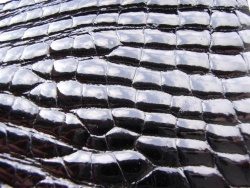Glazing leather
Glazing leather - Glazed leather
In the glazing treatment, the leather surface is compressed by strong friction and pressure so that it becomes smooth and shiny. To achieve a particularly high gloss, non-thermoplastic binders are previously applied to the leather surface, which do not become soft and sticky during processing. Therefore, mostly casein-based binders are used. The processing is carried out by a glazing machine. Nevertheless, the manual effort for the glazing is enormous, which increases the cost of production.
Strongly shining crocodile leather, lizard leather, snakeskin, turtle leather or ostrich legs are mostly glazed.
Especially for shoes, a waterproofing final lacquer is applied because of the additional, water-repellent effect. Glossy leather is otherwise extremely water-sensitive.
Glazed crocodile leather. - Glazed crocodile handbag (DLM - German Leather Museum in Offenbach).
Glazed ostrich leather leg. - Glazed python leather (DLM - German Leather Museum in Offenbach).
Additional information












 a kotori web solution
a kotori web solution